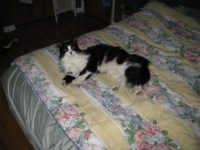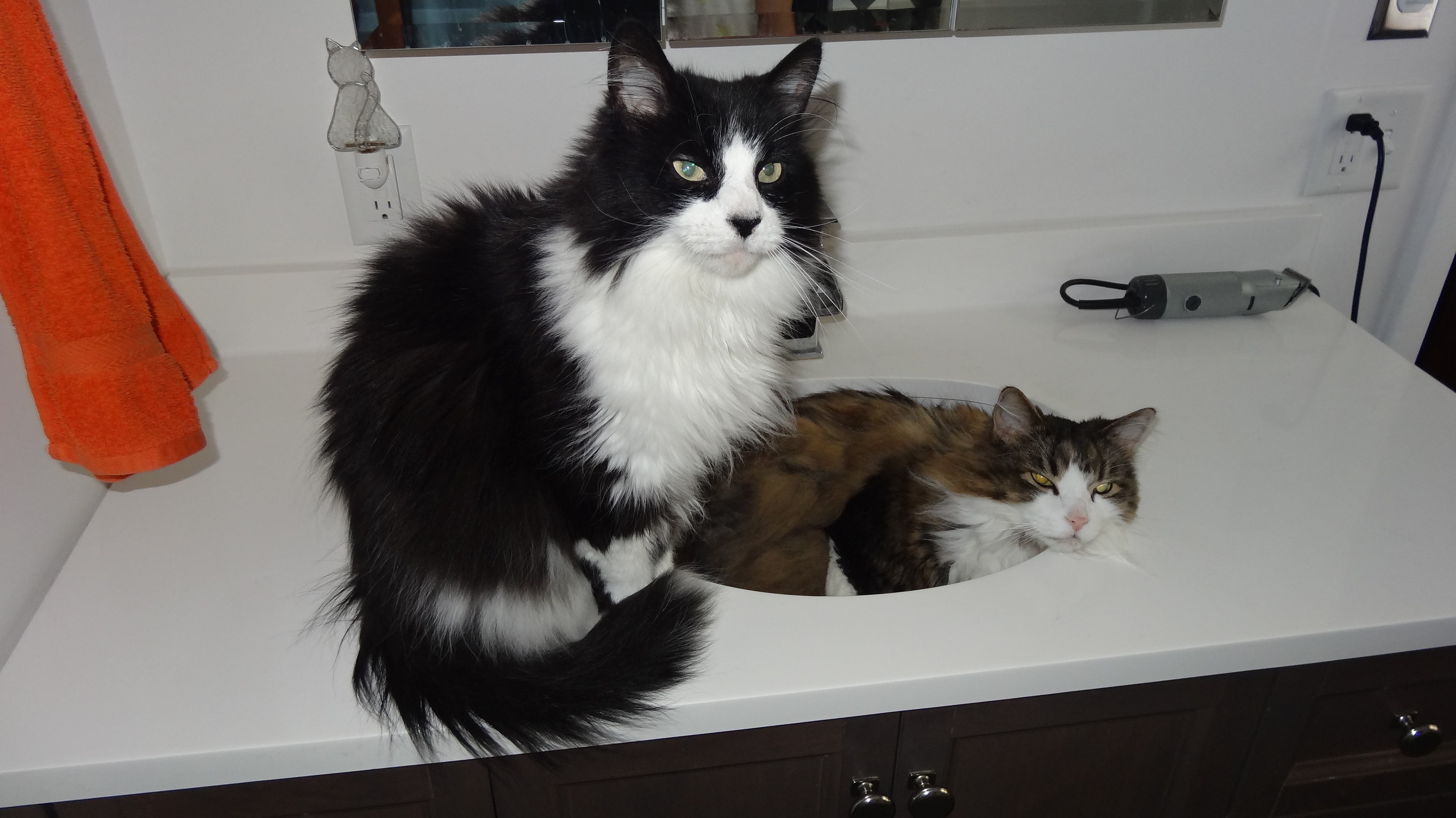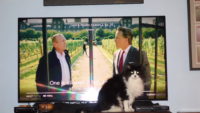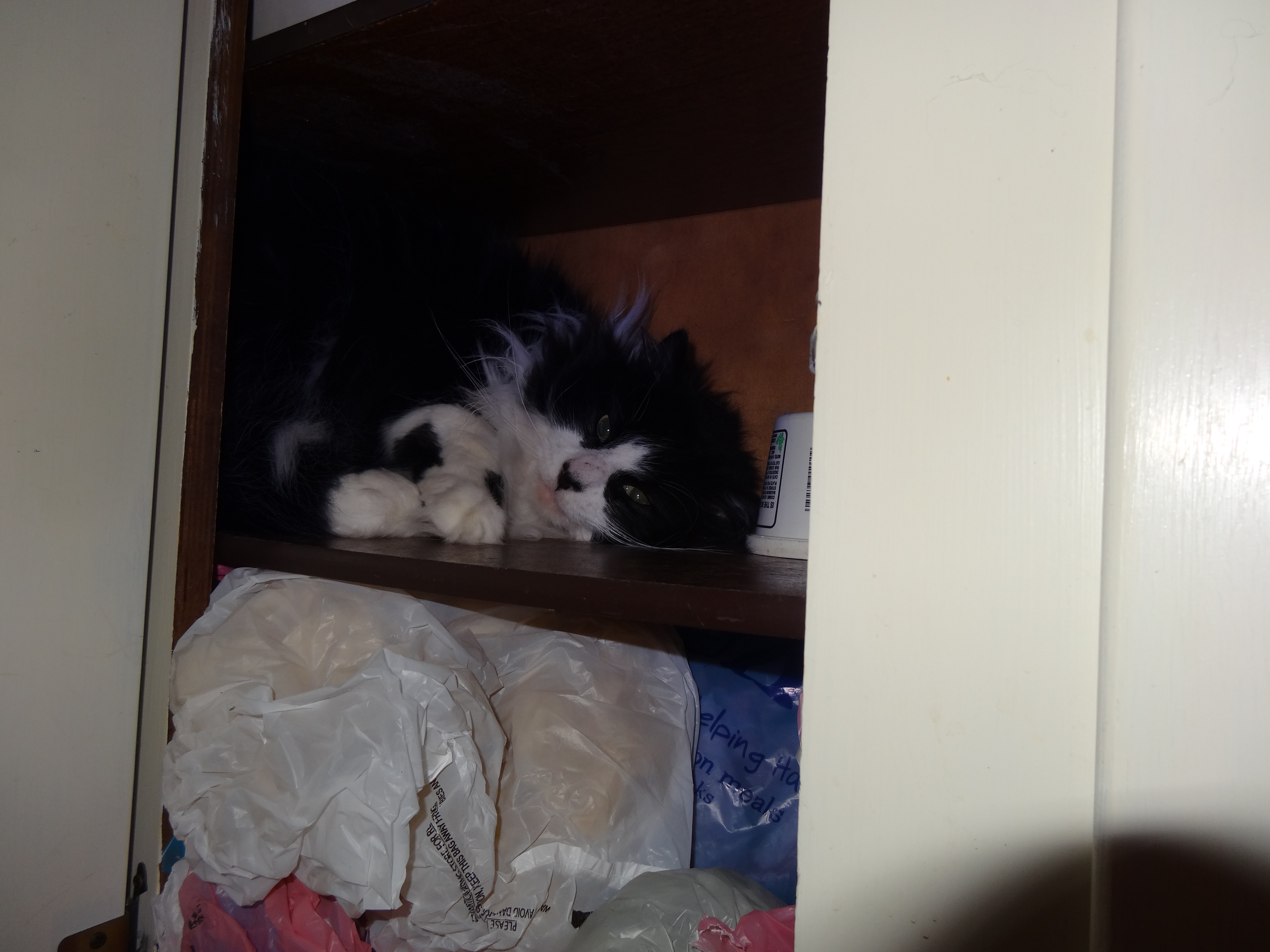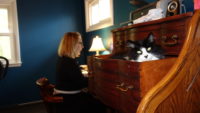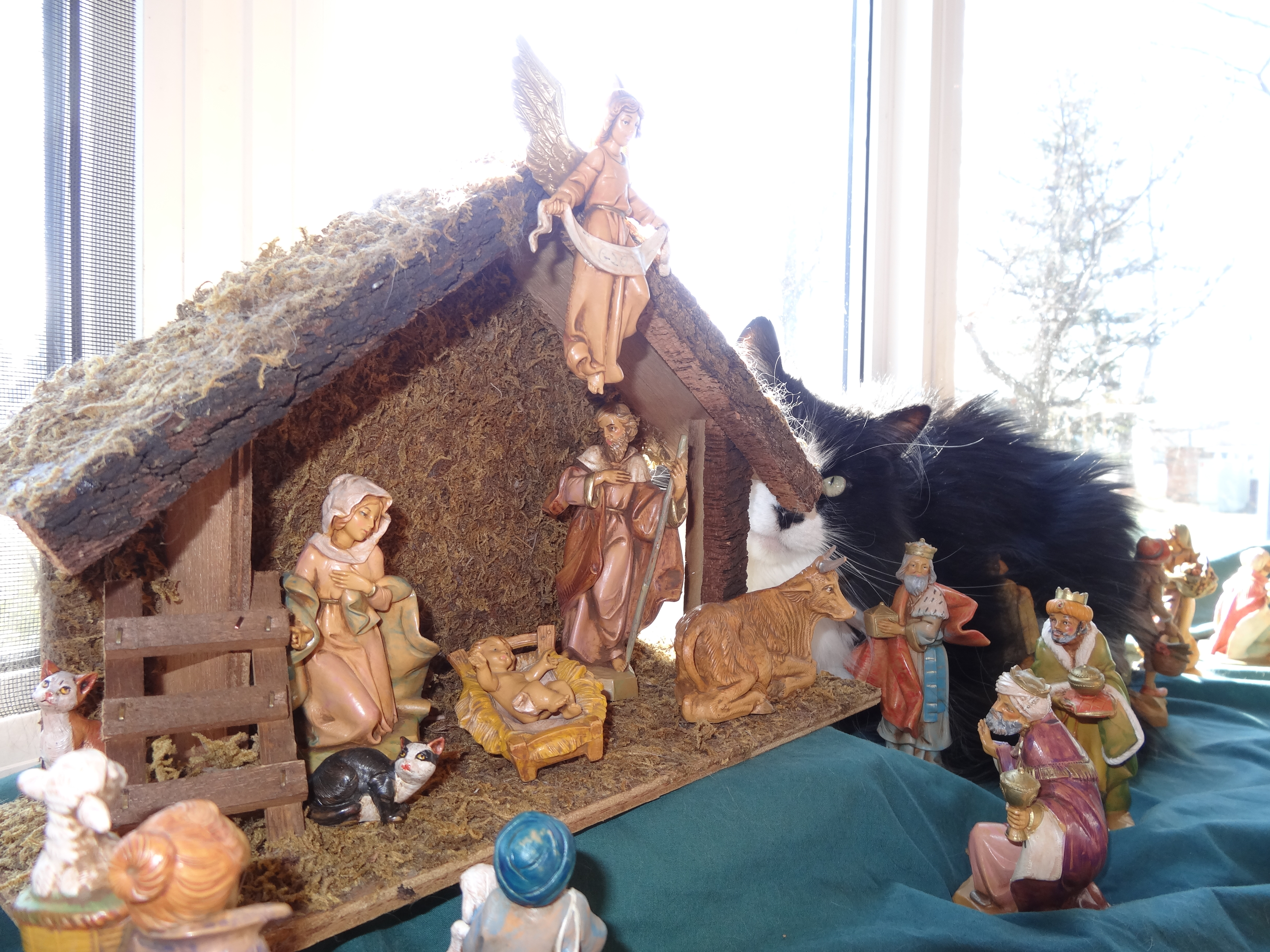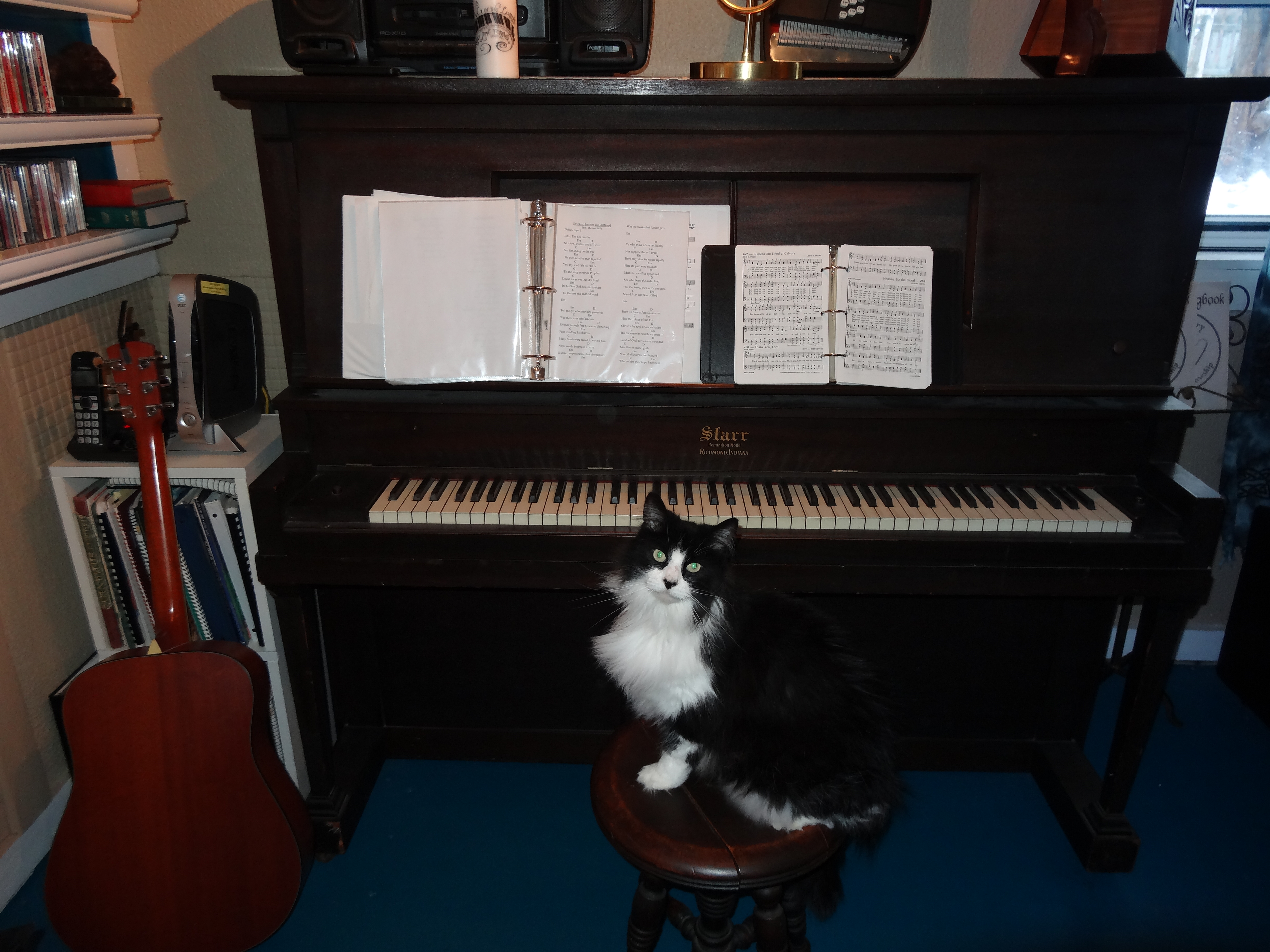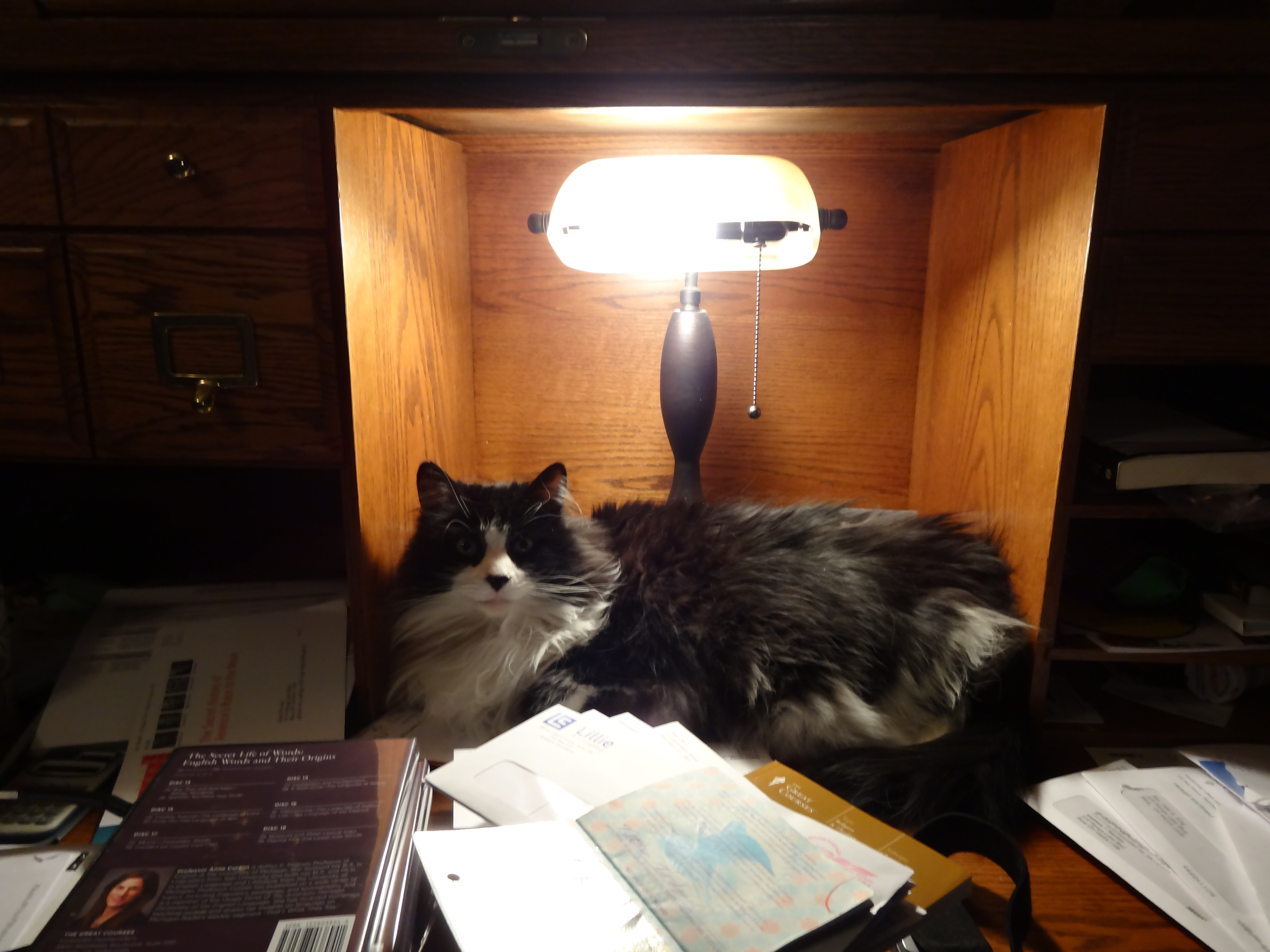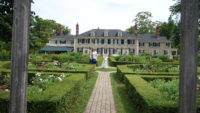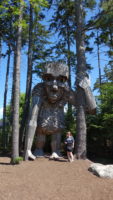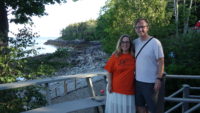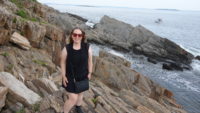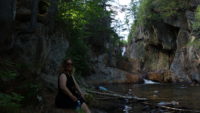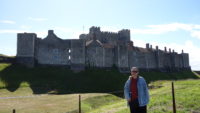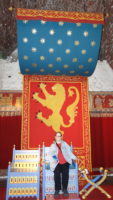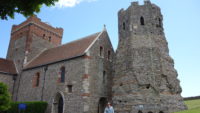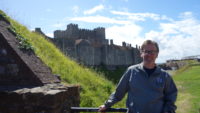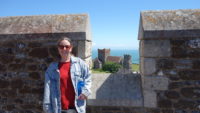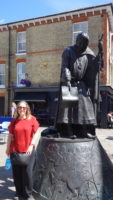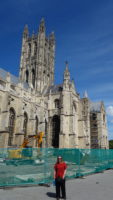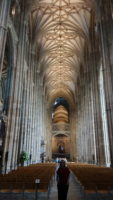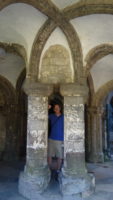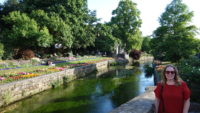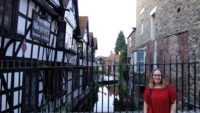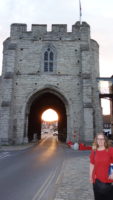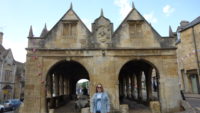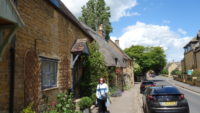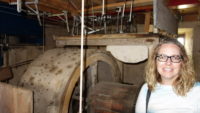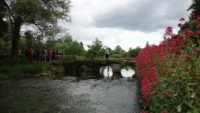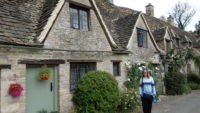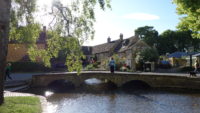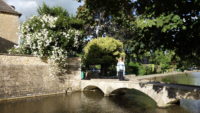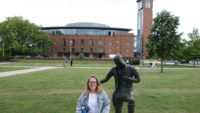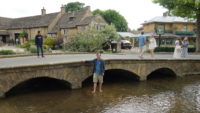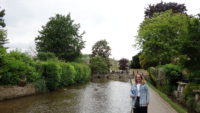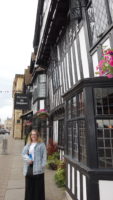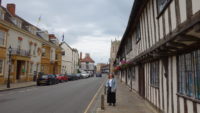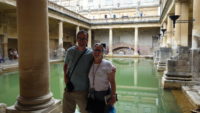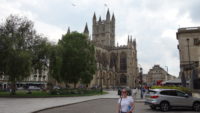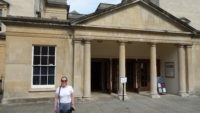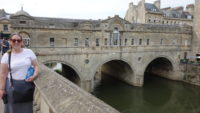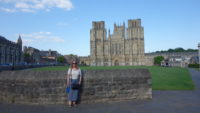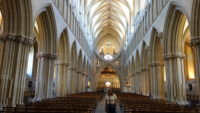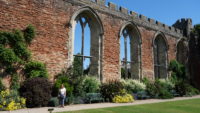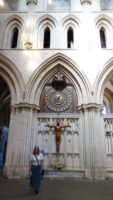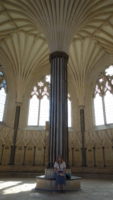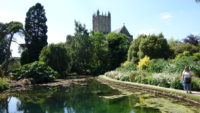 As I was preparing for the school day, I heard a knock on my classroom window. Opening the blinds, I saw my husband Matthew holding a beautiful long-haired tuxedo cat with a black nose and a white-tipped tail. It turned out that the cat had taken up residence underneath the trailers behind our school, and since it had been discovered there around the same time that the Hunger Games movie was released, the students started calling the cat Katniss.
As I was preparing for the school day, I heard a knock on my classroom window. Opening the blinds, I saw my husband Matthew holding a beautiful long-haired tuxedo cat with a black nose and a white-tipped tail. It turned out that the cat had taken up residence underneath the trailers behind our school, and since it had been discovered there around the same time that the Hunger Games movie was released, the students started calling the cat Katniss.
Many students were delighted to have a school cat. She was friendly, not feral, and I can picture her running across the grass to greet Matthew when he called to her. But with over eight hundred students in the building, I feared that there might be at least one or two who might try to hurt her. Every morning when I came to work, I had trouble relaxing until I’d seen her and knew that she was all right. Then one afternoon, when I came into my room before my next class was about to start, a couple girls were looking out the windows, and one of them gasped, “That boy is kicking the cat!”
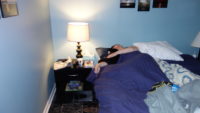 I stormed back into the hall and out the door, and it’s God’s good grace that a) the cat appeared unharmed, and b) the boy was nowhere in sight … because I really don’t know what I’d have done if I’d found him mid-kick. Something that could’ve gotten me fired, I suspect. But the incident convinced me that the cat couldn’t keep living behind the school, and that we needed to bring her home.
I stormed back into the hall and out the door, and it’s God’s good grace that a) the cat appeared unharmed, and b) the boy was nowhere in sight … because I really don’t know what I’d have done if I’d found him mid-kick. Something that could’ve gotten me fired, I suspect. But the incident convinced me that the cat couldn’t keep living behind the school, and that we needed to bring her home.
Convincing Matthew was a little trickier. We already had five cats, and he was reluctant to add a sixth. Though I’m not a frequent crier, the thought of the cat’s falling prey to any more abuse got my waterworks going. “I don’t want ‘another cat,’” I sobbed to Matthew, “but I want this one.”
Apparently, I wasn’t the only one who thought Katniss needed to be rescued, because before we had a chance to claim her, we learned that one of my students, Lauren, had taken her in. Yet Katniss didn’t get along with Lauren’s other pets, so Lauren took her to her local vet in hopes that someone there could find Katniss a better situation. At this point, the school year was almost over, and I went out of town briefly for senior trip. By the time I returned, Matthew had visited Lauren’s vet and brought Katniss home.
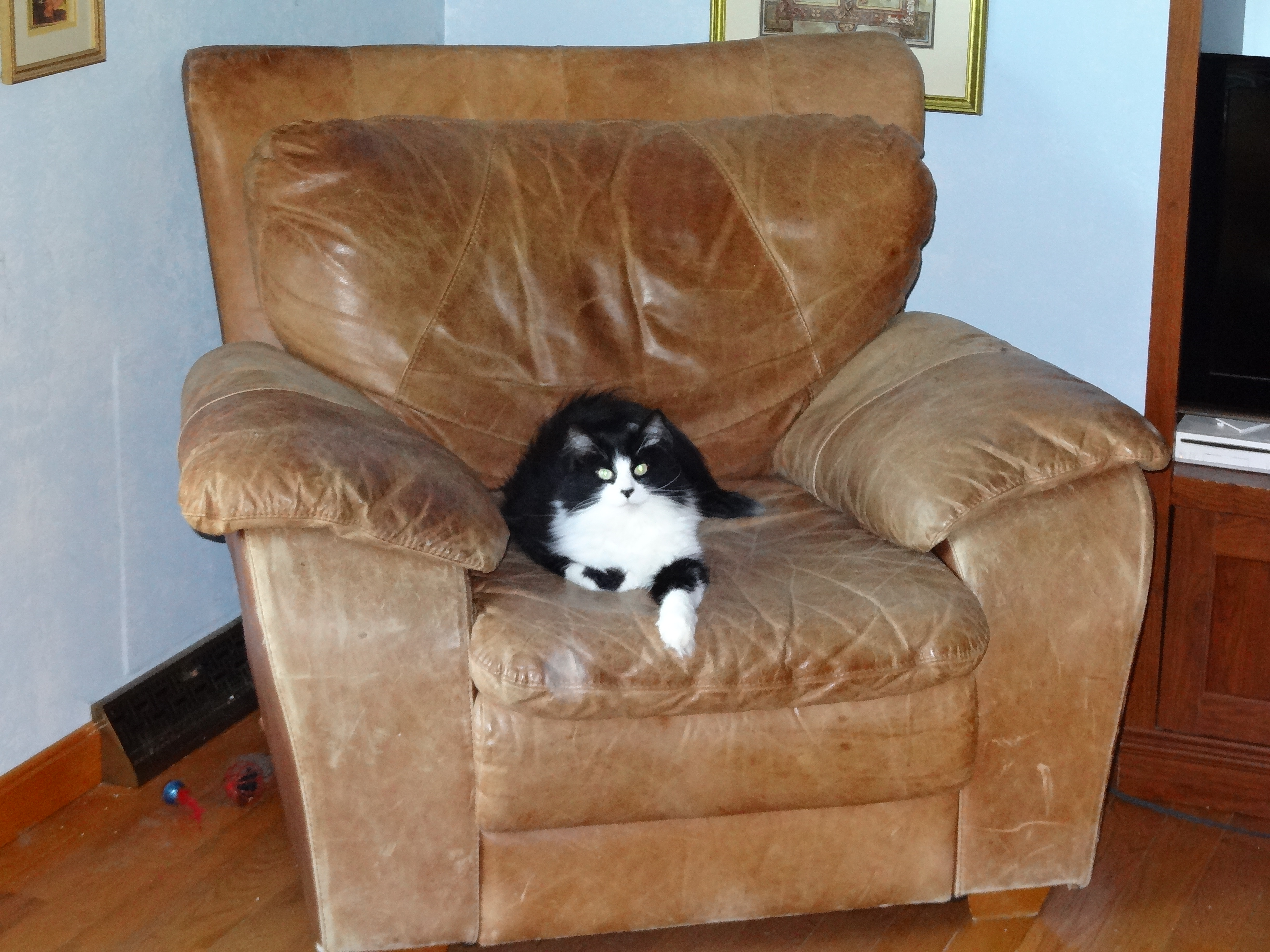 Some of the students had claimed that since Katniss was living outdoors and didn’t look totally clean, she must have had fleas, but they were wrong — not only about the fleas, but also about the “she,” as it turned out. I guess people think that fluffy cats look more feminine. Now we had a problem, though: we needed to find a new name. We tried several, but we were so used to thinking of the cat as Katniss that none of them stuck. Matthew said that since the name Katniss had been made up for The Hunger Games, it wasn’t inherently male or female. Because I’d read the trilogy, it seemed female to me; however, I was willing to compromise by changing the spelling to “Catness.” I figured that if, for example, “happiness” is “the condition of being happy,” “Catness” could mean “the condition of being a cat.”
Some of the students had claimed that since Katniss was living outdoors and didn’t look totally clean, she must have had fleas, but they were wrong — not only about the fleas, but also about the “she,” as it turned out. I guess people think that fluffy cats look more feminine. Now we had a problem, though: we needed to find a new name. We tried several, but we were so used to thinking of the cat as Katniss that none of them stuck. Matthew said that since the name Katniss had been made up for The Hunger Games, it wasn’t inherently male or female. Because I’d read the trilogy, it seemed female to me; however, I was willing to compromise by changing the spelling to “Catness.” I figured that if, for example, “happiness” is “the condition of being happy,” “Catness” could mean “the condition of being a cat.”
Unfortunately, the condition to which Catness had grown accustomed was that of being an outdoor cat, and in his early days with us, he was something of a flight risk. He wasn’t standoffish, but he was less affectionate than he’d seemed when at the school, and, most disturbingly, he liked to scratch everything. As owners of clawed cats, we’d limited curtains and rugs and replaced our cloth chairs and couches with harder-to-shred leather ones … yet Catness also scratched metal and wood. You can live in a house with minimal fabric, but it’s tough to eliminate metal and wood, and the gouges were adding up. When we’d adopted our first two cats from a Chicago shelter, we’d had to promise to keep them as indoor-only cats and not to declaw them. After having had Catness for a destructive year, though, we did finally decide that we’d never promised we wouldn’t have him declawed.
 To our relief, the surgery went smoothly, and besides healing quickly, Catness actually became more affectionate afterwards. Nonetheless, he still had a mischievous streak, especially when it came to food. Such as the time he figured out how to get into the cupboard above the counter so he could access his dry food. Or the time Matthew had covered a bowl of shredded chicken with a heavy, fragile plate while he briefly left the room; while the bowl was unattended, Catness managed to get up on the counter and knock the plate off the bowl without breaking it or upsetting the bowl itself, and was happily mid-munch by the time I found him. Such was his fondness for chicken that Matthew would usually just give him a little, in response to Catness’s plaintive wails. We called him “Chicken Monster,” since I’d warned Matthew early on that by giving in to those wails, he was creating a monster.
To our relief, the surgery went smoothly, and besides healing quickly, Catness actually became more affectionate afterwards. Nonetheless, he still had a mischievous streak, especially when it came to food. Such as the time he figured out how to get into the cupboard above the counter so he could access his dry food. Or the time Matthew had covered a bowl of shredded chicken with a heavy, fragile plate while he briefly left the room; while the bowl was unattended, Catness managed to get up on the counter and knock the plate off the bowl without breaking it or upsetting the bowl itself, and was happily mid-munch by the time I found him. Such was his fondness for chicken that Matthew would usually just give him a little, in response to Catness’s plaintive wails. We called him “Chicken Monster,” since I’d warned Matthew early on that by giving in to those wails, he was creating a monster.
However, Catness’s crowning food-related achievement involved pork, not chicken. I’d made some that was done cooking, so I opened the oven door, but to keep it safe while I went to the bathroom before dinner, I shoved the pan toward the back of the oven and only opened the oven door a little ways. Returning to the kitchen a few minutes later, I was shocked to see Catness sitting on the counter with a large hunk of pork hanging from his mouth. To this day, I have no idea how he managed that. The oven was still quite hot, and Catness didn’t even have claws that could’ve aided him in snagging the meat.
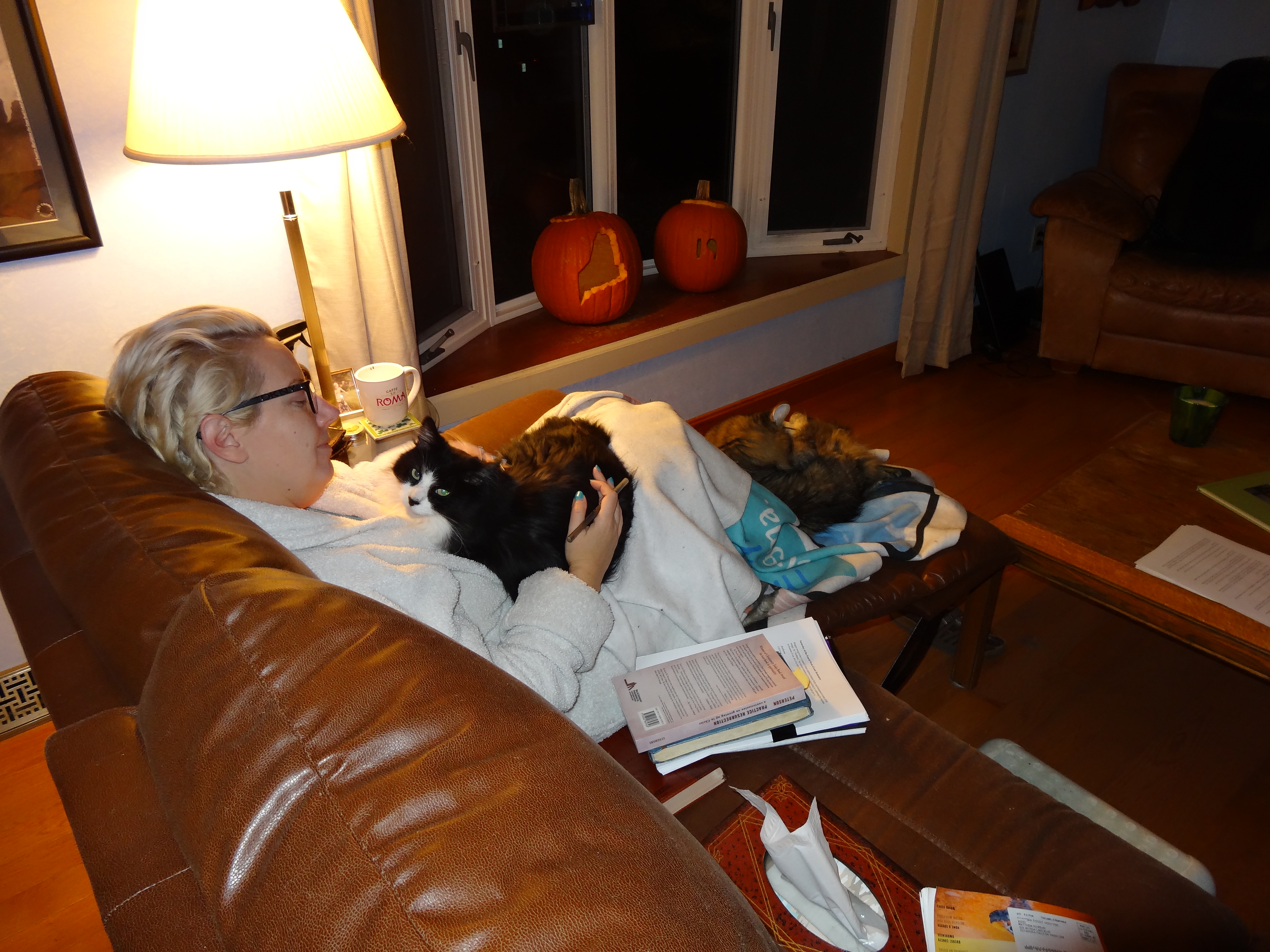 Occasional acts of food thievery notwithstanding, Catness was a great cat, as corroborated by multiple visitors who expressed a wish to take him home. He was so companionable with Sokhai, a young Cambodian man whom we hosted for a couple weeks, that in any of the sporadic e-mails we exchanged with Sokhai over the years, he always inquired about his “little friend.”
Occasional acts of food thievery notwithstanding, Catness was a great cat, as corroborated by multiple visitors who expressed a wish to take him home. He was so companionable with Sokhai, a young Cambodian man whom we hosted for a couple weeks, that in any of the sporadic e-mails we exchanged with Sokhai over the years, he always inquired about his “little friend.”
Catness was fond of most people, including Matthew, but he was my special baby. Sometimes he liked to sit on the bathroom counter and help me get ready in the morning. Sometimes he’d help me exercise — when I got out my floor mat, he’d roll around next to me as I stretched to pet him. Sometimes he’d join me while I watched TV; though not much of a lap cat, he’d curl up right next to me. However, my favorite snuggle times with Catness were on summer mornings when I could sleep in. He’d often sleep by my feet, but when he’d sense that I was starting to wake up, he’d come closer. If I lay on my side and stretched out my arm, he’d come rest his head on it, like a pillow, while curving his body against my torso. He was my Fluffy Gorgeous, my Black-Nosed Cutie, my Little Mr. Fluffy Paws. To the tune of “Papa Loves Mambo,” I’d sing, “Mama loves Catness — da da da daaa da da — Catness loves Mama — da da da daaa da da.”
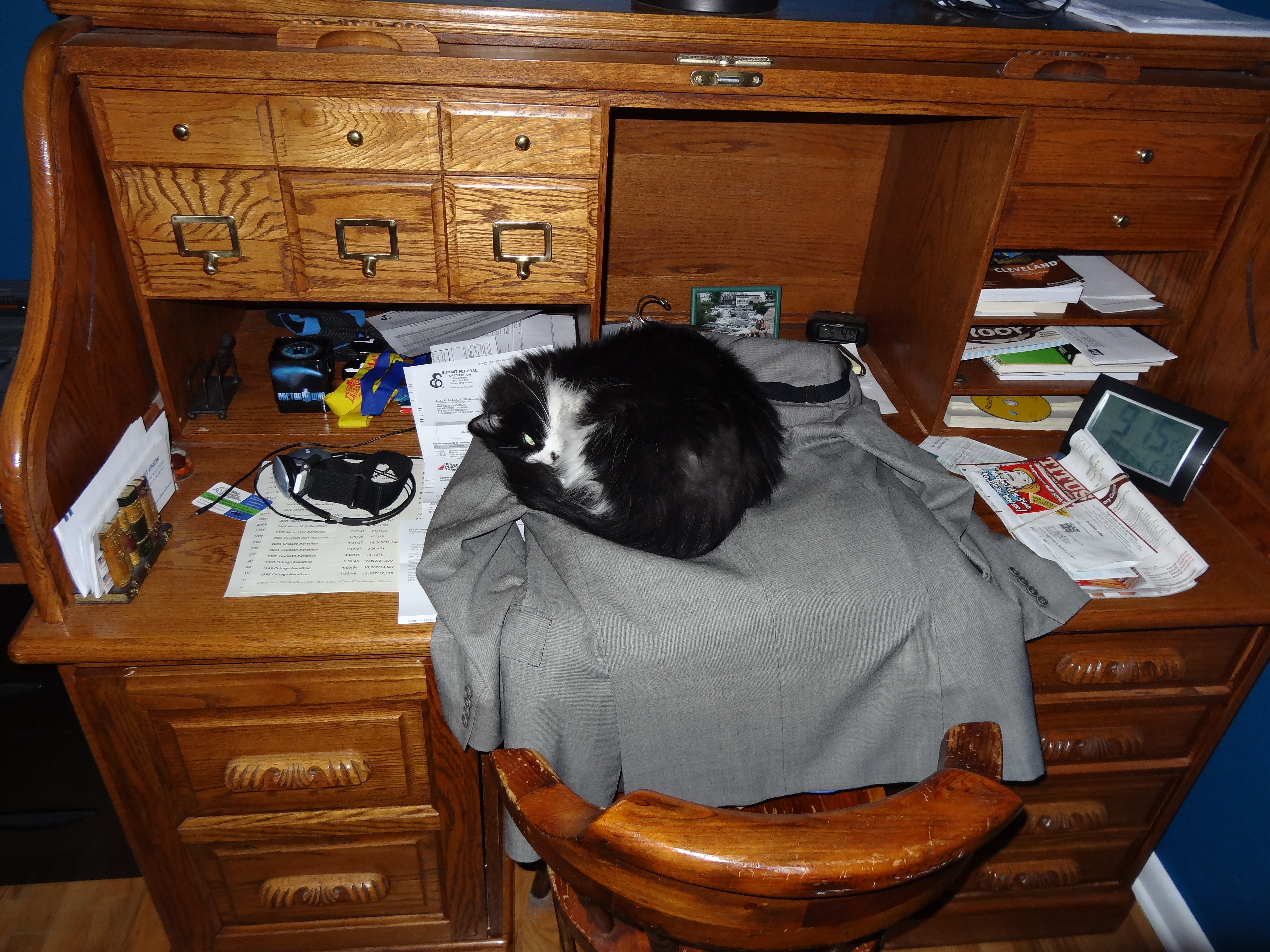 During the first year of the pandemic, Matthew and I, like many other people, got to spend lots of quality time with our pets, but when we had the chance to take a trip to Iceland last summer, we were eager to go. While we hate leaving the cats when we travel, we prefer it to the alternatives of not traveling or not having cats. Returning from Iceland, though, we encountered something new to us: Catness had not handled our absence well. He’d always been a cat who’d find a certain spot that would be his preferred spot for a time, maybe a couple weeks or so, and then he’d find a different one … yet after Iceland, this behavior got more extreme. He’d almost never leave his preferred spot, and seemed to have a particular aversion to being on the floor. We took him to the vet, but no one found anything physically wrong with him, so we hoped that he’d return to normal soon. A couple months later, he still hadn’t, so we took him to the vet again, but again, there was no indication of a health problem, and his appetite continued to be pretty good. (He’d never had any past health issues, either, except for the year or so that he turned into Sneezy Cat — allergies, the vet said. We weren’t sure what to do about this until Matthew had the radical idea that maybe it was time to have our furnace ductwork cleaned out, and that seemed to be the solution.)
During the first year of the pandemic, Matthew and I, like many other people, got to spend lots of quality time with our pets, but when we had the chance to take a trip to Iceland last summer, we were eager to go. While we hate leaving the cats when we travel, we prefer it to the alternatives of not traveling or not having cats. Returning from Iceland, though, we encountered something new to us: Catness had not handled our absence well. He’d always been a cat who’d find a certain spot that would be his preferred spot for a time, maybe a couple weeks or so, and then he’d find a different one … yet after Iceland, this behavior got more extreme. He’d almost never leave his preferred spot, and seemed to have a particular aversion to being on the floor. We took him to the vet, but no one found anything physically wrong with him, so we hoped that he’d return to normal soon. A couple months later, he still hadn’t, so we took him to the vet again, but again, there was no indication of a health problem, and his appetite continued to be pretty good. (He’d never had any past health issues, either, except for the year or so that he turned into Sneezy Cat — allergies, the vet said. We weren’t sure what to do about this until Matthew had the radical idea that maybe it was time to have our furnace ductwork cleaned out, and that seemed to be the solution.)
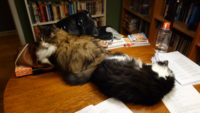 In lieu of physical explanations for Catness’s recent behavior, I considered psychological ones. One time when Catness was leaving the litter box, I saw him get pounced on by Folio and Selkie, our newest additions to the family, both less than a year old. They seemed playful rather than hostile, and Catness hadn’t had a problem with them before we left for Iceland, but perhaps because he was getting older as they were getting bolder, or perhaps because he didn’t have claws with which to defend himself, he saw them as a threat. At the same time, when his preferred spot was one that had room for them too, such as on a couch or a bed, he rarely seemed bothered by their being near him.
In lieu of physical explanations for Catness’s recent behavior, I considered psychological ones. One time when Catness was leaving the litter box, I saw him get pounced on by Folio and Selkie, our newest additions to the family, both less than a year old. They seemed playful rather than hostile, and Catness hadn’t had a problem with them before we left for Iceland, but perhaps because he was getting older as they were getting bolder, or perhaps because he didn’t have claws with which to defend himself, he saw them as a threat. At the same time, when his preferred spot was one that had room for them too, such as on a couch or a bed, he rarely seemed bothered by their being near him.
To try to accommodate Catness’s determination to play “The Floor Is Lava,” Matthew and I responded with a determination to play “Musical Litter Boxes (and Food and Water Dishes).” Whenever Catness would switch his preferred spot, we’d make sure he had food, water, and litter nearby, whether his spots were more obvious ones (like beds or couches) or quirkier ones (like my clothes hamper, a nook in Matthew’s roll top desk, or either of the bathroom sinks). For a time, when we thought that the other cats might’ve been causing his stress, we tried keeping him in our bedroom with the doors shut, to give him a safe space — which meant that Matthew and I slept apart: I stayed with Catness, and Matthew slept in the guest room, so that the other cats could be with him. But eventually, Catness seemed restless, and we opened the room again.
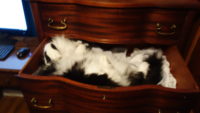 For a few months, I kept hoping Catness would improve; however, a day came when he took a definite step in the wrong direction. This was one of the times when my hamper was his preferred spot, and one day, while we were watching, he stood up and urinated on my clothes, despite there being a litter box in close proximity. It was quick and easy enough to wash the clothes, but his willingness to foul his own nest was clearly a bad sign. We bought puppy pee pads and layered them with old towels, changing out both regularly, and we took him back to the vet. At this point, physical issues were becoming apparent, and he was starting to lose weight. Even so, he continued to eat — and to be affectionate, purring when petted and rolling over so we could rub his belly.
For a few months, I kept hoping Catness would improve; however, a day came when he took a definite step in the wrong direction. This was one of the times when my hamper was his preferred spot, and one day, while we were watching, he stood up and urinated on my clothes, despite there being a litter box in close proximity. It was quick and easy enough to wash the clothes, but his willingness to foul his own nest was clearly a bad sign. We bought puppy pee pads and layered them with old towels, changing out both regularly, and we took him back to the vet. At this point, physical issues were becoming apparent, and he was starting to lose weight. Even so, he continued to eat — and to be affectionate, purring when petted and rolling over so we could rub his belly.
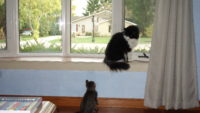 While we knew that Catness wasn’t in great shape, he wasn’t in rapid decline, either, over the next few months. During the winter, we’d bought tickets to go to England in the summer, so when June came, we went. We’d explained to our cat sitter about keeping food, water, and litter near Catness’s preferred spot (the downstairs bathroom sink, at that time) and about changing out and washing the towels. I felt a bit apprehensive about leaving him, yet wasn’t anticipating major changes in the couple weeks we’d be gone. And there didn’t seem to be any. Our cat sitter didn’t report any problems, and our friend Dubbs came over to visit the cats and took pictures of the ones who stuck around long enough to let her, which included Catness, now in the tub but looking otherwise unchanged.
While we knew that Catness wasn’t in great shape, he wasn’t in rapid decline, either, over the next few months. During the winter, we’d bought tickets to go to England in the summer, so when June came, we went. We’d explained to our cat sitter about keeping food, water, and litter near Catness’s preferred spot (the downstairs bathroom sink, at that time) and about changing out and washing the towels. I felt a bit apprehensive about leaving him, yet wasn’t anticipating major changes in the couple weeks we’d be gone. And there didn’t seem to be any. Our cat sitter didn’t report any problems, and our friend Dubbs came over to visit the cats and took pictures of the ones who stuck around long enough to let her, which included Catness, now in the tub but looking otherwise unchanged.
Getting home, we found Catness in the tub; however, I felt a cold knot start to form in my stomach when I saw that the food near him was uneaten. Thinking that perhaps it hadn’t been put close enough, I set it right next to him, and he still had no interest. The next morning, after seeing that he hadn’t eaten anything in the night, Matthew made one more vet appointment. I tried to tell myself that it wasn’t the final vet appointment, but when I saw my stoic husband’s red eyes and the crumpled tissues in his hands, I couldn’t lie to myself any longer: I knew I only had a couple more hours with Catness. We moved him down to the couch, where I stroked his still-silky fur, now wet with my tears, and told him how much I loved him. When Catness’s eyes started to glaze and his breathing grew labored, Matthew called and begged the vet’s office to let us bring him in sooner, which they did.
 Catness was a part of our home for ten years. I cried in my yearning to have him, and I cried to have to let him go. When we already had five cats, I’d never intended to get another … but I’m so glad I got that one.
Catness was a part of our home for ten years. I cried in my yearning to have him, and I cried to have to let him go. When we already had five cats, I’d never intended to get another … but I’m so glad I got that one.
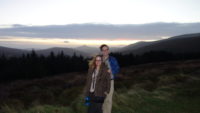 A few months back I stumbled across $460 tickets to Dublin, and so we decided to go back to Ireland for the second time in 2022, and we invited our colleagues Regina Pykare and Meredith Neufeld (“Neuf” to distinguish her from the Meredith to whom I’m married) and Regina’s daughter, Shelby. We’ve all traveled together before, and Neuf had expressed a desire to get to Ireland at some point, so that was a nice bonus.
A few months back I stumbled across $460 tickets to Dublin, and so we decided to go back to Ireland for the second time in 2022, and we invited our colleagues Regina Pykare and Meredith Neufeld (“Neuf” to distinguish her from the Meredith to whom I’m married) and Regina’s daughter, Shelby. We’ve all traveled together before, and Neuf had expressed a desire to get to Ireland at some point, so that was a nice bonus.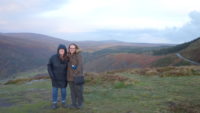 And so, Ireland. We picked up our car, which the company had bumped up to the next class for us, which was fortunate, since we filled the trunk completely and all the non-drivers had to hold a backpack (or, in Mer’s case, my fairly light suitcase). Not ideal, but it was the price for getting a car that I felt okay driving (aka, not a passenger van). We were never in the car for more than ninety minutes at a stretch, so I didn’t feel too bad, especially since Shelby and Neuf managed to fall asleep for the longest stretch.
And so, Ireland. We picked up our car, which the company had bumped up to the next class for us, which was fortunate, since we filled the trunk completely and all the non-drivers had to hold a backpack (or, in Mer’s case, my fairly light suitcase). Not ideal, but it was the price for getting a car that I felt okay driving (aka, not a passenger van). We were never in the car for more than ninety minutes at a stretch, so I didn’t feel too bad, especially since Shelby and Neuf managed to fall asleep for the longest stretch.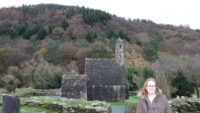 After coming out of the Wicklow Mountains, which we had largely to ourselves (I think we saw four cars in an hour), we drove over to the old monastic settlement of Glendalough. Glendalough was an important site, founded in the sixth century, with most of the current buildings from the Irish ecclesiastical boom time of 1100-1200. There is a still-active cemetery with many Celtic crosses, several intact buildings (including an Irish round tower), and a few ruins. All of these are set in a beautiful setting of small mountains, a stream, two lakes, and thick forests. And it’s free to visit (except for a four-euro parking fee). It was very cold as the area clouded over, and the wind was fierce, but we escaped the rain that moved in just as we finished up. And then we drove out of it. Good timing.
After coming out of the Wicklow Mountains, which we had largely to ourselves (I think we saw four cars in an hour), we drove over to the old monastic settlement of Glendalough. Glendalough was an important site, founded in the sixth century, with most of the current buildings from the Irish ecclesiastical boom time of 1100-1200. There is a still-active cemetery with many Celtic crosses, several intact buildings (including an Irish round tower), and a few ruins. All of these are set in a beautiful setting of small mountains, a stream, two lakes, and thick forests. And it’s free to visit (except for a four-euro parking fee). It was very cold as the area clouded over, and the wind was fierce, but we escaped the rain that moved in just as we finished up. And then we drove out of it. Good timing.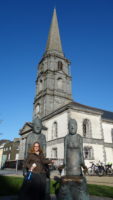 I drove us the ninety minutes to Waterford, but I had to stop for caffeine and sugar along the way, as I was approaching twenty-four hours of no sleep. Waterford was pleasing to drive into – there is a Christmas fair going on right now, right on the river, and our hotel is downtown too, so I could drop the car and forget about it for awhile. The only unfortunate thing is that out hotel’s official check-in time was 4:00. Since Mer and I bank on getting a three-hour nap to help us shake jetlag, and we usually can get into rooms by 1:00 (or even earlier), that was a setback.
I drove us the ninety minutes to Waterford, but I had to stop for caffeine and sugar along the way, as I was approaching twenty-four hours of no sleep. Waterford was pleasing to drive into – there is a Christmas fair going on right now, right on the river, and our hotel is downtown too, so I could drop the car and forget about it for awhile. The only unfortunate thing is that out hotel’s official check-in time was 4:00. Since Mer and I bank on getting a three-hour nap to help us shake jetlag, and we usually can get into rooms by 1:00 (or even earlier), that was a setback. Mer and I rode the Ferris wheel, which gave decent views of the town and river, and in the dark, we could see the Christmas lights around town. We had planned on exploring the booths of the fair, but they were all shut down by 7:30 on this Sunday, so we went to a pub instead. We wanted supper and were hoping for music. While we ate supper, the waiter put a soccer game on, and it was Ireland versus Malta, which was funny since my brother, Shannon, his wife Jolene, and our friend Dubbs are in (or, for Dubbs, is on her way) to Malta this week. Ireland won, 1-0.
Mer and I rode the Ferris wheel, which gave decent views of the town and river, and in the dark, we could see the Christmas lights around town. We had planned on exploring the booths of the fair, but they were all shut down by 7:30 on this Sunday, so we went to a pub instead. We wanted supper and were hoping for music. While we ate supper, the waiter put a soccer game on, and it was Ireland versus Malta, which was funny since my brother, Shannon, his wife Jolene, and our friend Dubbs are in (or, for Dubbs, is on her way) to Malta this week. Ireland won, 1-0.